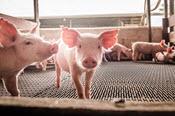
While American pork producers appreciate the USDA’s aid package, they would prefer more market opportunities and trade resolutions
By Kate Ayers
Staff Writer
Better Farming
Canadian livestock producers are caught in the crossfire of ongoing trade disputes between the United States and some of its trading partners.
Producers are forced “to make business decisions on how they manage their operations and act accordingly,” said Keith Currie, president of the Ontario Federation of Agriculture.
“But it is kind of a wait-and-see game because the end result is out of our hands.”
In addition to the U.S. trade disruptions causing ripple effects for commodity prices, Donald Trump, the president of the United States, announced a US$12-billion aid package in July to help American farmers.
The government included hog producers in this compensatory package.
“The whole trade mitigation package is really a three-legged stool,” Dustin Baker, director of economics and domestic production issues for the National Pork Producers Council, said to Better Farming.
“The first leg is known as the Market Facilitation Program (MFP) and that really functions as direct payments to producers.
“In order to qualify for a payment, producers have to own the animals and (they must have) adjusted gross incomes of (no more) than US$900,000 from 2014 through to 2016,” he explained.
“If they pass those two hurdles, then their payments are equal to the number of hogs that they had on Aug. 1 times 50 per cent times US$8.” The USDA extended this timeline with a two-week window on either side of Aug. 1, allowing producers to choose a date that accurately represents the number of live hogs they own.
Another central piece of the overall mitigation package is the Food Purchase and Distribution Program.
For this initiative, “the government goes out and purchases commodities and puts them into its nutrition assistance programs and food banks. About 45 per cent of the total funds allocated to that (program) are in pork purchases,” Baker said.

Davy3 Photo/iStock/Getty Images Plus photo
“Not all the pork producers in the country will qualify for the Market Facilitation Program but the Food Purchase and Distribution Program really has the potential to lift all boats and provide the greatest benefit to all producers.”
The Foreign Agricultural Service facilitates the third, smaller element: the Agricultural Trade Promotion Program.
“It’s US$200 million and that is for market development, public relations and advertising,” Baker said.
Some producers have already received support from the aid package.
“The last numbers that I saw (showed that) … a total of US$240 million in payments have been paid across all commodities as part of the MFP,” Baker said.
“That amounts to about 5 per cent of the overall funds that the USDA plans to distribute as part of the MFP.”
Industry and government officials are discussing a second round of payments from this aid package. But the USDA does not plan to extend this support into 2019, Sonny Perdue, the U.S. secretary of agriculture, said to reporters in October.
A “second payment is likely, but it will be based on 2018 production numbers. The program won’t extend to the 2019 crop year or inventories,” Baker said.
The administration will “revisit (this topic) in December and a (second) payment could still occur by the end of 2018.”
American pork producers and the National Pork Producers Council welcome the support through the aid package, but they would prefer to see trade resolutions and more market availability.
“Our standpoint throughout this entire process has been that we are appreciative of being included in the MFP and the Food Purchase and Distribution Program, but the bottom line is that we need to protect and expand our marketing opportunities abroad,” Baker said.
“Certainly, for the farmers who qualify for the payment, it’s welcome. But it is not going to make them whole.” BF



Post new comment